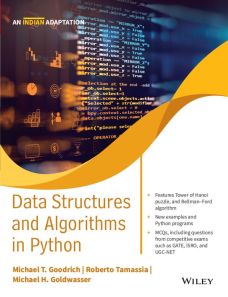Data Structures and Algorithms in Python (An Indian Adaptation)
ISBN: 9789354247866
808 pages
Publication Year: 2021
For more information write to us at: acadmktg@wiley.com

Description
Data Structures and Algorithms in Python offers a comprehensive, definitive introduction to data structures and algorithms, including their design, analysis, and implementation in Python. Utilizing a consistent object-oriented viewpoint throughout the book, it provides detailed algorithmic strategies for producing efficient realizations of common data structures such as arrays, stacks, queues, linked lists, trees, maps, hash tables, search trees, and graphs. The book also provides an in-depth analysis of algorithmic performance that helps readers to recognize common trade-offs between competing strategies. The book incorporates a host of pedagogical features, including illustrations, code fragments, and end-of-chapter exercises.
Chapter 1 Introduction to Python
1.1 Python Overview
1.2 Objects in Python
1.3 Expressions, Operators, and Precedence
1.4 Control Flow
1.5 Functions
1.6 Simple Input and Output
1.7 Exception Handling
1.8 Iterators and Generators
1.9 Additional Python Conveniences
1.10 Scopes and Namespaces
1.11 Modules and the Import Statement
Chapter 2 Object-Oriented Programming
2.1 Goals, Principles, and Patterns
2.2 Software Development
2.3 Class Definitions
2.4 Inheritance
2.5 Namespaces and Object-Orientation
2.6 Shallow and Deep Copying
Chapter 3 Introduction to Data Structures and Algorithms
3.1 Data Structures
3.2 Experimental Studies
3.3 The Seven Functions Used in this Book
3.4 Analysis of Algorithms
3.5 Simple Justification Techniques
Chapter 4 Recursion
4.1 Examples Illustrating Recursion
4.2 Analyzing Recursive Algorithms
4.3 Further Examples of Recursion
4.4 Designing Recursive Algorithms
4.5 Eliminating Tail Recursion
Chapter 5 Array-Based Sequences
5.1 Python’s Sequence Types
5.2 Low-Level Arrays
5.3 Dynamic Arrays and Amortization
5.4 Efficiency of Python’s Sequence Types
5.5 Using Array-Based Sequences
5.6 Multidimensional Data Sets
Chapter 6 Stacks
6.1 Stacks
6.2 The Stack Abstract Data Type
6.3 Simple Array-Based Stack Implementation
Chapter 7 Queues
7.1 Queues
7.2 The Queue Abstract Data Type
7.3 Array-Based Queue Implementation
7.4 Double-Ended Queues
7.5 Circular Queues
Chapter 8 Linked Lists
8.1 Singly Linked Lists
8.2 Circularly Linked Lists
8.3 Doubly Linked Lists
8.4 The Positional List ADT
8.5 Sorting a Positional List
8.6 Link-Based vs. Array-Based Sequences
Chapter 9 Trees
9.1 General Trees
9.2 Binary Trees
9.3 Implementing Trees
9.4 Tree Traversal Algorithms
9.5 Case Study: An Expression Tree
Chapter 10 Priority Queues
10.1 The Priority Queue Abstract Data Type
10.2 Implementing a Priority Queue
10.3 Heaps
10.4 Adaptable Priority Queues
Chapter 11 Maps, Hash Tables, and Sets
11.1 Maps and Dictionaries
11.2 Hash Tables
11.3 Sorted Maps
11.4 Sets, Multisets, and Multimaps
Chapter 12 Search Trees
12.1 Binary Search Trees
12.2 Balanced Search Trees
12.3 AVL Trees
12.4 Splay Trees
12.5 (2, 4) Trees
12.6 Red-Black Trees
Chapter 13 Sorting Algorithms
13.1 Why Study Sorting Algorithms?
13.2 Merge-Sort
13.3 Quick-Sort
13.4 Studying Sorting through an Algorithmic Lens
13.5 Sorting with a Priority Queue
13.6 Comparing Sorting Algorithms
13.7 Python’s Built-In Sorting Functions
Chapter 14 Graph Algorithms
14.1 Graphs
14.2 Data Structures for Graphs
14.3 Graph Traversals
14.4 Transitive Closure
14.5 Directed Acyclic Graphs
14.6 Shortest Paths
14.7 Minimum Spanning Trees
Chapter 15 Text Processing
15.1 Abundance of Digitized Text
15.2 Pattern-Matching Algorithms
15.3 Dynamic Programming
15.4 Text Compression and the Greedy Method
15.5 Tries
Chapter 16 Memory Management and B-Trees
16.1 Memory Management
16.2 Memory Hierarchies and Caching
16.3 External Searching and B-Trees
16.4 External-Memory Sorting
Illustrative Examples and Programs
Exercises
Multiple Choice Questions
Chapter Notes
Answers to Multiple Choice Questions
Appendix A Character Strings in Python
Appendix B Useful Mathematical Facts
Appendix C Additional Searching and Sorting Algorithms
Bibliography
Index

